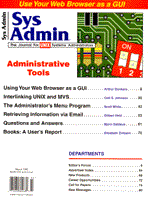
New Messages
Please send letters via email to saletter@rdpub.com.
Subject: comment on Jul/Aug issue Emmett Dulaney's "When Inodes Go Bad" did a good job of covering typical filesystem problems, but I fear it may cause needless worry by not qualifying the very first fsck message: "POSSIBLE FILE SIZE ERROR." I get one of these every time I boot my machine, but have learned to ignore it. Sometimes this message can safely be ignored, because "POSSIBLE" is there for a reason. Some databases -- including some created by UNIX system administration utilities -- create big files with "holes" in them. If more than 1 block of a file is never initialized, it need not have a disk block assigned to it. Then the number of blocks assigned to the file can be less -- often much less! -- than the length of the file that's declared in its inode. This is perhaps the commonest cause of this apparently alarming message. The proper course of action is to use ncheck -i to identify the file. If it's one of those likely to contain holes, don't worry; the filesystem is really OK. For further details, see the discussion on pp.187-188 of Thomas & Farrow's UNIX Administration Guide for System V. A.T. Young Thanks for the reference. I'm not certain this should put anyone at ease, but I don't think I've ever identified a "real" problem related to "POSSIBLE FILE SIZE ERROR." I do, however, remember being very concerned about these messages when we first started using UNIX. Maybe your letter can bring a little peace of mind to other beginning admins who are encountering this message -- rlw Subject: Article in Sys Admin Just read your article in SysAdmin (Using Linux as a Router, Jan., 1996), and I was wondering which ISDN TA you were using, as it wasn't mentioned in the article. BTW, thanks for writing the article, as that and the other one on Linux were what convinced me to buy this issue.
Looking forward to hearing from you,
Eric,
Cheers!
Subject: Article in January Sys Admin
1) What version of the Linux kernel are you using? 2) Where did you get gated? As far as I can tell it is not included with Slackware 2.3. I have found the source at Merit but was wondering if you had located a precompiled version for Linux. TIA!
Andrew C. Moody
Andrew, An "as-is" version of the gated executable & config files is available in:
ftp://moria.co.chatham.ga.us/pub/gated.bin.tar.z
If you want source obtained from Cornell, get it from Cornell, or:
ftp://moria.co.chatham.ga.us/pub/gated.R3_0_3.tar.Z
Be warned that the most recent versions of gated (which the above is not) will require IP Multicasting to be enabled in your kernel.
Cheers,
|